How Philadelphia startup Proscia is bringing cancer biopsies into the digital age
How Philadelphia startup Proscia is bringing cancer biopsies into the digital age
The company’s Concentriq AP Dx software allows pathologists to make a primary diagnosis from an image on their computer screen, rather than a glass slide.
The American Cancer Society predicts that new cancer cases in the U.S. will hit an all-time high this year of over 2 million. That amounts to nearly 5,500 cancer diagnoses a day. In nearly all kinds of cancer, a diagnosis—and often decisions about treatment—hinges on the laboratory analysis of an abnormal tissue sample, a.k.a. a biopsy. In the U.S. alone, there are many millions of biopsies performed annually—over 1 million each to screen for breast cancer and prostate cancer, and over 5 million for skin cancer.
The overwhelming majority of biopsies are still read and interpreted the same way they have been for decades: by a human pathologist examining thin slices of tissue on a glass slide under a microscope. Each biopsy is a judgment call, and pathologists often disagree—in “grading” the severity of prostate cancer, for example, the “concordance rate” among experts can be less than 60%. Getting a second opinion has traditionally meant shipping a physical slide to another doctor’s office, eating into valuable treatment time.
But that’s starting to change, and digital pathology startup Proscia aims to accelerate the process, with an intuitive, scalable platform for storing, sharing, and analyzing of super-high-resolution digital slides—just as demand for biopsies threatens to outpace our collective capacity to keep up the two- to three-day turnaround time we’ve come to expect in the U.S.
Based in Philadelphia since 2018, Proscia has ridden a wave of interest in the emerging digital pathology space, raising $37 million in June 2022 (bringing its total funding to $72 million), and in February 2024 obtaining FDA clearance for its Concentriq AP Dx software, which allows pathologists and clinical providers of all sizes to make a primary diagnosis from an image on their computer screen, rather than a glass slide.
The approval has been a game changer for Proscia, which now has 95 employees, but according to co-founder and CEO David West, it’s only the beginning.
From Glass to Pixels
Given the widespread adoption of telehealth and machine learning to interpret MRIs and other radiology scans, the lack of digitization and automation in the field of pathology came as a shock to West, then a computational biology student at Johns Hopkins University. “I was working with some amazing scientists building computer vision and machine learning algorithms to predict cancer outcomes,” says West. “I started scratching my head and thinking, why can we do this in an academic setting but when you go to an actual laboratory they’re still stuck on microscopes?” That question led West to co-found Proscia in 2014.
The sticking point was the ability to scan physical slides at sufficiently high resolution to allow pathologists to zoom in on structural details just as they would with a microscope. It wasn’t until 2017 that the FDA authorized a whole-slide imaging (WSI) system, made by Philips, which allowed an entire tissue section to be scanned on a single digital slide that could be used for diagnostic purposes. In 2020 the FDA approved a second system for primary diagnosis, made by Swedish company Sectra and U.S. lab equipment maker Leica Biosystems.
Today, says West, “there’s a dozen different scanners out there, maybe two dozen at this point. A handful have been FDA approved. The opportunity that we saw was to create a new software category—where the pathologist spends all their time, where the data lives, and where [new] AI models are getting deployed.” Data storage has been another roadblock to adoption of digital pathology—images used for medical diagnosis are around a billion pixels each. Proscia’s Concentriq system provides a secure cloud platform that allows users to securely store, share, and work with whole slide images from any type of scanner. “That’s part of why our customers adopt our software,” says West. “The other reason is because they want to get AI models into their workflows.”
Proscia aims to be “the AWS of cancer,” providing the management and digitization layer that’s necessary to actually develop AI tools. “You can now bring together machine learning, computer vision, and cloud computing to recognize patterns in whole slide images in ways not possible with the microscope and naked eye,” says West. This won’t replace experienced pathologists, but rather, he says, “an AI based test can tell me where to look, and I’m going to confirm what the AI is saying. I suspect it will be that way for a long time.”
Magnifying Impact
Proscia raised a $1 million seed round in 2016, and found an early market with customers in pharma, biotech, and contract research organizations, who used the platform for research, not for diagnostic purposes. West says that 14 of the top 40 pharmaceutical companies are currently using the company’s Concentriq for Research platform. But for the last three years, West says, the company has worked to bring digital pathology to hospital systems and commercial lab services companies, where it can impact patients more directly.
Last March, Proscia announced distribution partnerships with lab equipment maker Agilent and Siemens Healthineers, a leading supplier of medical imaging tools. And with the FDA approval for Proscia’s Concentriq AP Dx software earlier this year—a version of its research software specifically designed for clinical customers to deploy at commercial scale—it has helped the company build a user base of some 10,000 pathologists and scientists, according to West. Today, Proscia’s customers include both “name-brand health systems,” and some of the largest lab-test providers, including privately held PathGroup, which works with more than 4,000 physician practices and 200-plus hospital customers.
“For laboratories to scale their implementations and realize the benefits of digital
pathology, they need a solution that is easy to learn and intuitive to use,” says West. Derek Welch, MD, PathGroup’s chief medical officer, says that his company is all in. “PathGroup pathologists exclusively utilize Proscia’s platform for all of our primary read digital workflow for all biopsy types,” Welch says. “It’s a powerful tool that allows us to utilize any market-available scanner. [Other] advantages include speed of user access and case review, immediate consultation capabilities across geographies, and [the ability for pathologists to] work from home. Also, digitization of histology slides is a prerequisite for any application of AI tools, whose clinical utility we’re just now beginning to understand through trials with various vendors.”
Proscia’s West estimates that about 15% of biopsy slides are now handled digitally, and adds, “That’s double where it was last year. And analysts say it’s going to be double again next year.”
As more large labs like PathGroup embrace digital pathology, it could be a win-win for patients and pathologists—and could even help fend off an impending crisis, as increased demand for biopsies meets a declining supply of trained pathologists. One commonly cited study found that between 2007 and 2017, the U.S. workforce of trained pathologists declined by 17.5%. According to data from a 2021 survey by the College of American Pathologists, fewer than two thirds of practices were able to fill all their open pathology positions, and over 26% of open FTE positions remained unfilled. And a 2022 survey of more than 1,200 “in-practice” pathologists found that nearly half (48%) experienced burnout at least “part of the time.”
West says that the crisis has already hit Europe, where “the workforce fell past a certain threshold while cancer rates were increasing and in a few years they went from two or three day turnaround times to around three month average-turnaround times. The U.S. has one of the best pathology workforces in the world, but it’s declining and getting very close to that threshold.”
ABOUT THE AUTHOR
(22)



